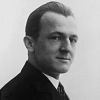George Grosz

George Grosz
George Groszwas a German artist known especially for his caricatural drawings and paintings of Berlin life in the 1920s. He was a prominent member of the Berlin Dada and New Objectivity group during the Weimar Republic. He emigrated to the United States in 1933, and became a naturalized citizen in 1938. Abandoning the style and subject matter of his earlier work, he exhibited regularly and taught for many years at the Art Students League of New York. In 1956 he...
NationalityGerman
ProfessionPainter
Date of Birth26 July 1893
CityBerlin, Germany
CountryGermany
The war was a mirror; it reflected man's every virtue and every vice, and if you looked closely, like an artist at his drawings, it showed up both with unusual clarity.
It's an old ploy of the bourgeoisie. They keep a standing 'art' to defend their collapsing culture.
The bourgeoisie and the petty bourgeoisie have armed themselves against the rising proletariat with, among other things, culture. It's an old ploy of the bourgeoisie. They keep a standing art to defend their collapsing culture.
In public buildings set aside for the care and maintenance of the goods of the middle ages, a staff of civil service art attendants praise all the dead, irrelevant scribblings and scrawlings that, at best, have only historical interest for idiots and layabouts.
The neutrality and clarity of an engineering drawing is a better model for teaching about art than all the uncontrollable drivel about the cabbala and metaphysics and the ecstasy of sainthood.
My aim is to be understood by everyone. I reject the 'depth' that people demand nowadays, into which you can never descend without a diving bell crammed with cabbalistic bullshit and intellectual metaphysics. This expressionistic anarchy has got to stop... A day will come when the artist will no longer be this bohemian, puffed-up anarchist but a healthy man working in clarity within a collectivist society.
How did I come to be an artist ? Endless curiosity, observation, research - and a great amount of joy in the thing
In the end, they pardoned me and packed me off to a home for the shell-shocked. Shortly before the end of the war, I was discharged a second time, once again with the observation that I was subject to recall at any time.
I don't even like to talk about it. I hated being a number and not merely because I was a very small one. I let them bellow at me for just as long as it took me to find enough pluck to bellow back at them.
I thought the war would never end. And perhaps it never did, either.
Peace was declared, but not all of us were drunk with joy or stricken blind.
When John Heartfield and I invented photomontage in my South End studio at five o'clock on a May morning in 1916, neither of us had any inkling of its great possibilities, nor of the thorny yet successful road it was to take. As so often happens in life, we had stumbled across a vein of gold without knowing it.
I had grown up in a humanist atmosphere, and war to me was never anything but horror, mutilation and senseless destruction, and I knew that many great and wise people felt the same way about it.
I was disappointed, not because we had lost the war but because our people had allowed it to go on for so many years, instead of heeding the few voices of protest against all that mass insanity and slaughter.